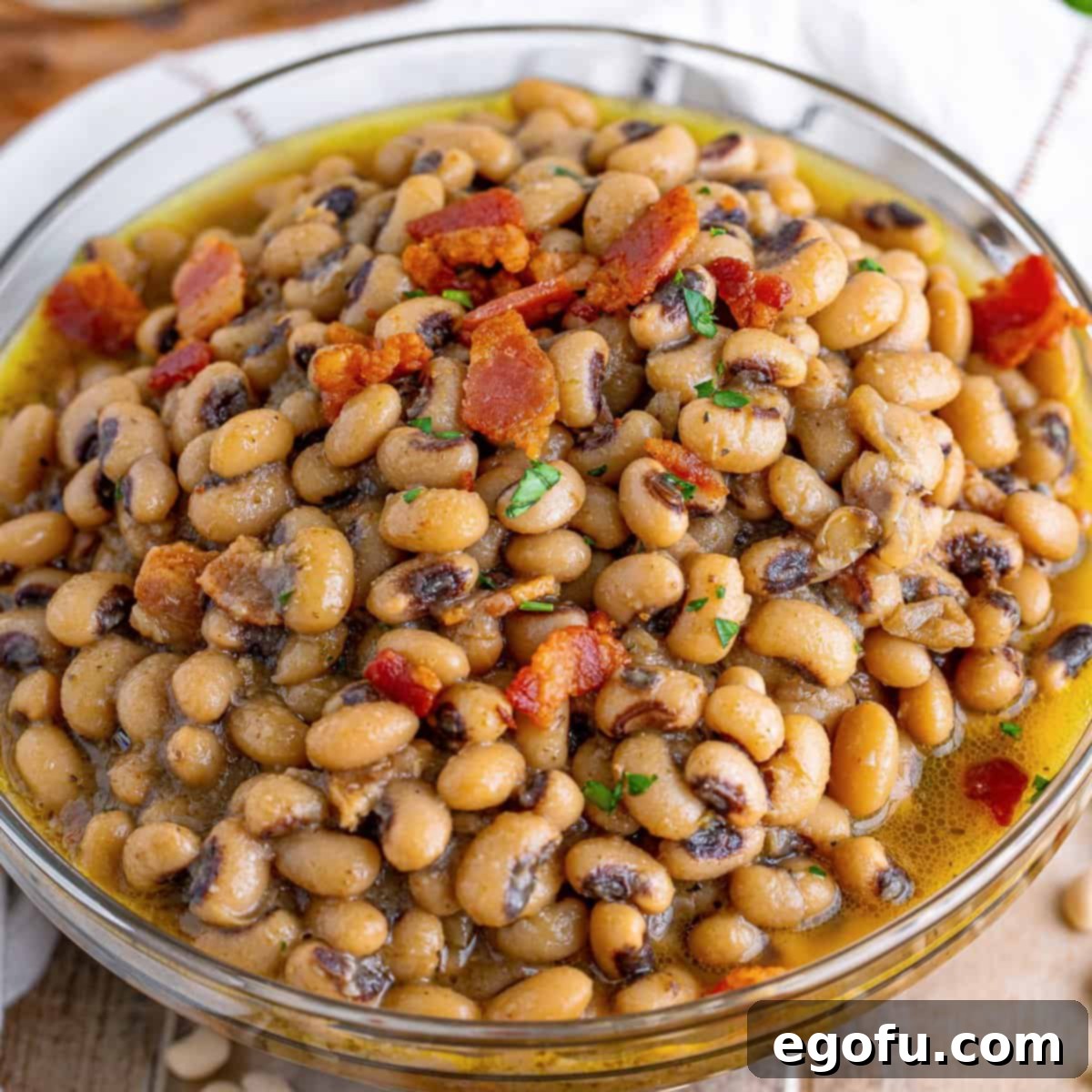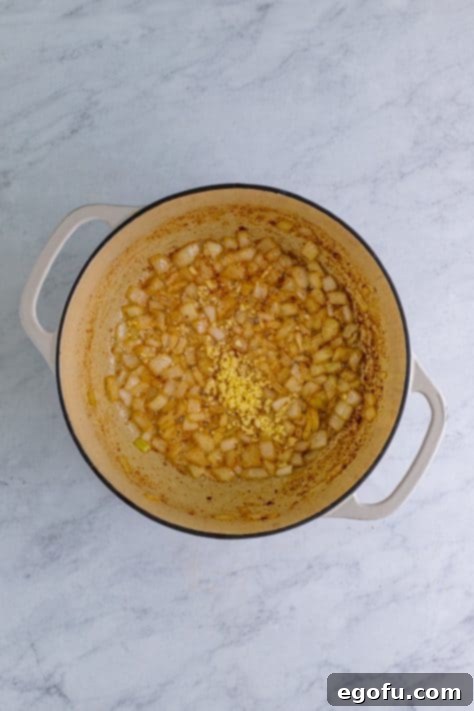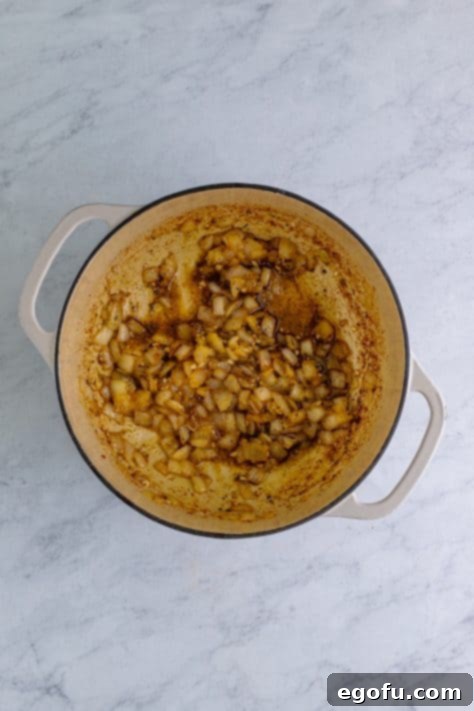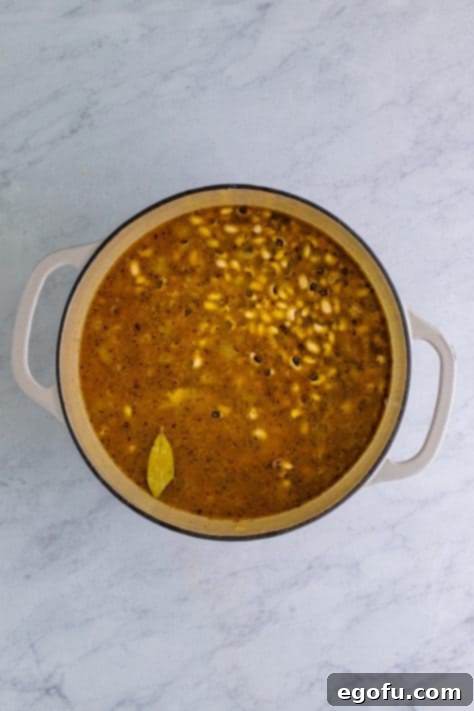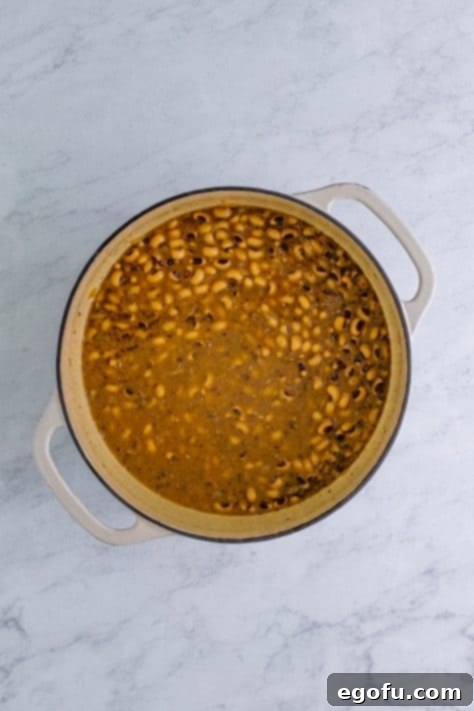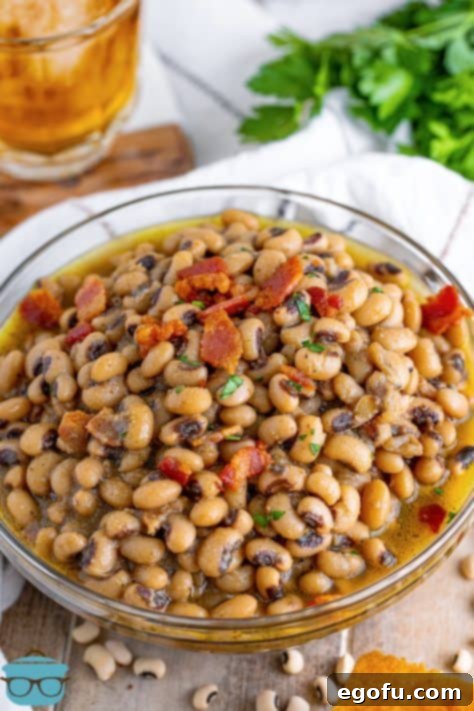Indulge in the rich, comforting flavors of the South with these exquisite Black Eyed Peas. Infused with savory bacon and a blend of aromatic seasonings, this dish transcends a mere side item to become a cherished centerpiece for any meal. It’s more than just food; it’s a taste of tradition and warmth.
A Classic Southern Black Eyed Peas Recipe: A Culinary Journey
There are few dishes that evoke such a powerful sense of home and heritage as a hearty pot of Southern Black Eyed Peas. For many, the mere aroma of bacon, onion, and garlic simmering gently with these humble legumes on the stovetop is a signal of comfort, family, and tradition. While they are a staple on New Year’s Day, believed to bring good luck and prosperity for the year ahead, this versatile and incredibly flavorful dish deserves a place on your table far more often. Our recipe takes the classic preparation to new heights, creating a dish so irresistibly delicious that it’s bound to become a regular fixture in your culinary repertoire. We dive deep into the heart of Southern cooking, combining simple ingredients with time-honored techniques to produce black-eyed peas that are tender, deeply savory, and perfectly seasoned. Prepare to transform your kitchen into a haven of Southern hospitality with this exceptional recipe.

Frequently Asked Questions About Black Eyed Peas
While often referred to as peas due to their appearance and the way they are cooked, black eyed peas are actually a type of bean. They belong to the legume family, which encompasses both beans and peas. Specifically, they are a subspecies of the cowpea, known for their distinctive black “eye” on the lighter-colored bean.
The tradition of eating black eyed peas for good luck dates back to the Civil War era in the Southern United States. During this tumultuous time, black eyed peas were considered feed for livestock and were often overlooked by foraging soldiers. Consequently, they became a crucial food source for Southerners, symbolizing survival and resilience. Eating them on New Year’s Eve or New Year’s Day is believed to bring prosperity and good fortune for the coming year. This cherished tradition has been passed down through generations, evolving into a widely celebrated cultural practice, particularly in the Southern states, though their deliciousness is enjoyed nationwide.
For this specific recipe, I highly recommend using thick-cut applewood smoked bacon. The robust, smoky flavor and substantial texture of thick-cut bacon truly elevate the dish, infusing the black eyed peas with an unparalleled depth of taste. However, if thick-cut isn’t available or you have a different preference, feel free to use any of your favorite bacon varieties, whether it’s regular-cut, hickory smoked, or another type. The key is to render out that delicious bacon fat, which forms the flavor foundation for the entire dish.
For the best results and a significantly reduced cooking time, it is essential to soak your dried black eyed peas overnight, for at least 8 hours. This process rehydrates them, allowing them to soften and cook more evenly. If you find yourself short on time, you can utilize a “quick soak” method: place the peas in a large pot, cover them with water, bring to a rolling boil for 2 minutes, then remove from heat, cover, and let them sit for 1 hour. After either method, thoroughly drain the peas before proceeding with the recipe.
This recipe includes a subtle hint of spice from the cayenne pepper, which adds a pleasant warmth without being overpowering. If you prefer your dishes milder, you can simply omit the cayenne pepper. For those who love a bit more heat, feel free to double the amount of cayenne or even add a dash of your favorite hot sauce to taste during the final stages of cooking or at the table. Customizing the spice level ensures everyone can enjoy this flavorful dish.
Black Eyed Peas are incredibly versatile and pair wonderfully with a wide array of Southern comfort foods. Some traditional and highly recommended accompaniments include fluffy white rice, crispy Southern Fried Chicken, hearty Chicken Fried Steak, warm and buttery Bacon Cornbread, savory Collard Greens, flaky Buttermilk Biscuits, or tender Glazed Ham. A platter of these sides transforms a simple meal into a festive feast.
Absolutely! The slow cooker is an excellent tool for preparing black eyed peas, making the process even more hands-off. After soaking the black eyed peas overnight, proceed with cooking the bacon and onion as directed in the stovetop instructions. Then, simply transfer all the ingredients into your slow cooker, mix well, and cook on low for approximately 3-4 hours, or until the peas are tender and fully cooked. This method is perfect for busy days or when you want to keep your stovetop free.
Leftover black eyed peas store beautifully. Place them in an airtight container and refrigerate for up to 3 days. For longer storage, black eyed peas freeze exceptionally well. Transfer the cooled peas to a freezer-safe container or heavy-duty freezer bags and freeze for up to 3 months. To defrost, simply remove from the freezer and allow to thaw in the refrigerator overnight. When reheating, you may notice the peas have thickened considerably; add a splash of water or chicken stock to achieve your desired consistency before warming them on the stovetop or in the microwave.
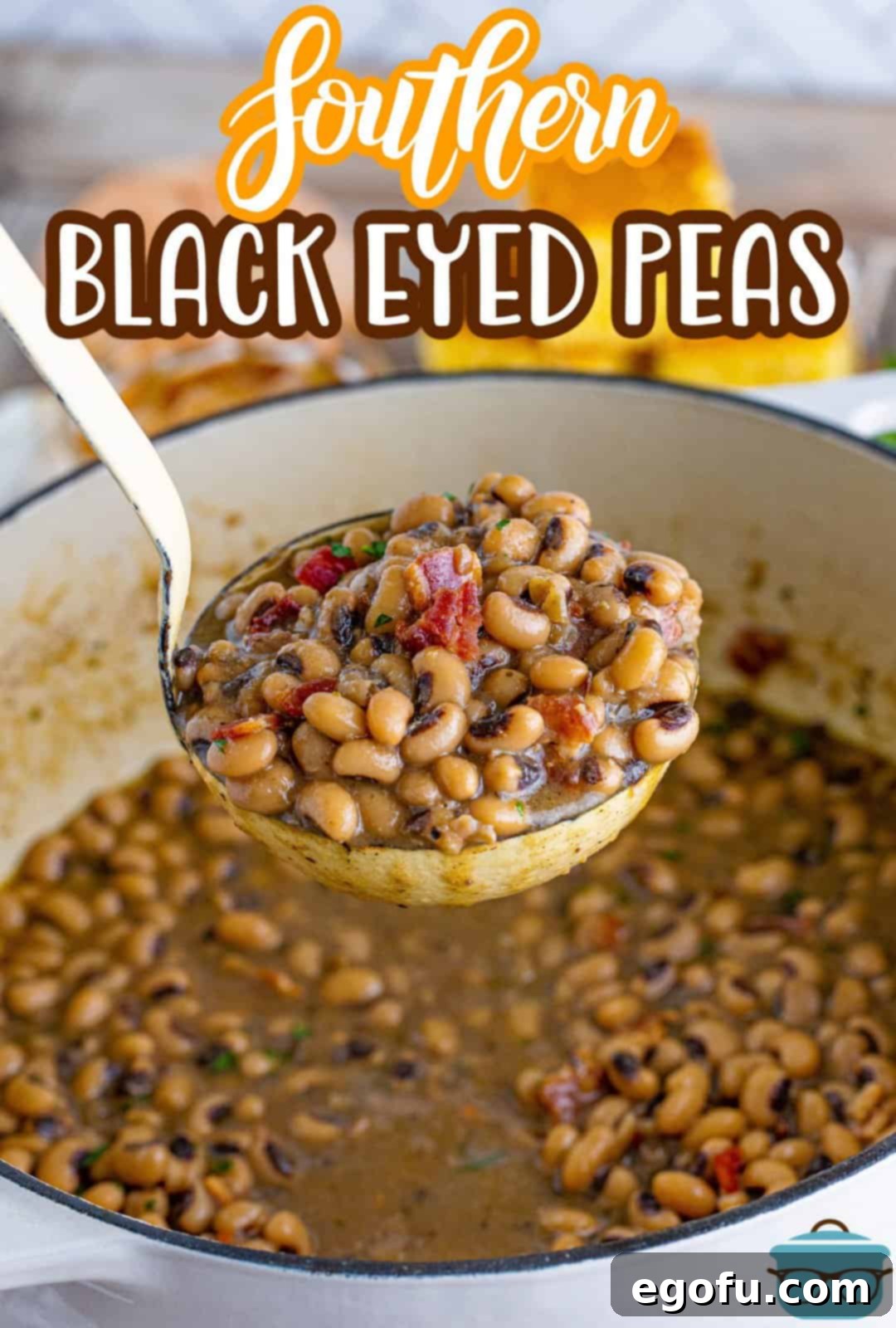
Essential Ingredients for Perfect Southern Black Eyed Peas
Crafting truly exceptional Southern Black Eyed Peas starts with selecting the right ingredients. Each component plays a vital role in building the layered flavors that make this dish so beloved. Here’s a closer look at what you’ll need and why each one is important:
- Thick-Cut Bacon: The cornerstone of flavor in this recipe. I highly recommend thick-cut bacon for its rich, smoky essence and the generous amount of flavorful drippings it provides. These drippings are crucial for sautéing the aromatics and adding a foundational savory note to the entire dish. While regular bacon works, thick-cut offers a superior depth of flavor and texture.
- Sweet Onion: A small sweet onion, such as a Vidalia, is ideal. Its mild sweetness caramelizes beautifully in the bacon fat, contributing a gentle, aromatic base without overwhelming the other ingredients. If a sweet onion isn’t available, a shallot can also be used, offering a more delicate oniony-garlic flavor.
- Fresh Garlic: For many recipes, jarred garlic is acceptable, but for a dish where garlic plays such an integral role, fresh is truly best. Freshly minced garlic delivers a pungent, vibrant flavor that cannot be replicated by its jarred counterparts, which are often preserved in oils and water, diluting their intensity. Taking an extra minute to peel and mince fresh garlic will significantly impact the final taste.
- A Blend of Seasonings (Seasoned Salt, Garlic Powder, Onion Powder, Thyme, Black Pepper, and Cayenne Pepper): This carefully balanced blend provides the signature Southern kick and aromatic complexity. Seasoned salt adds an all-in-one savory base, while garlic and onion powders layer on a consistent depth of flavor. Dried thyme contributes an earthy, herbaceous note. Black pepper offers a universal spice, and a touch of cayenne pepper introduces a mild, traditional Southern heat. Adjust the cayenne to your preference – Southerners often enjoy a little ‘kick,’ sometimes even adding extra hot sauce at the table.
- Dried Black-Eyed Peas: The star of the show! Always start with dried black-eyed peas for the most authentic flavor and best texture. Before soaking, make sure to sort through them to remove any small stones or debris that may have inadvertently mixed in. This is a normal and necessary step. Then, place them in a large bowl, cover with water (at least two inches above the peas), cover, and refrigerate overnight for proper rehydration. While some suggest salting the soaking water for other beans, it’s not essential for this recipe, as plenty of flavor will be added during cooking. Refer to the FAQ section for a “quick soak” alternative if time is short.
- Unsalted Chicken Stock: Using unsalted chicken stock instead of water is a game-changer for flavor. It infuses the peas with a savory richness without making the dish overly salty, especially since seasoned salt and bacon are already contributing sodium. This allows for better control over the final seasoning.
- Bay Leaves: Often underestimated, bay leaves add a subtle yet profound background note, imparting a slightly herbaceous and earthy aroma that gives the dish a complex “je ne sais quoi.” They contribute a depth of flavor that is hard to pinpoint but definitely missed if omitted.
- Unsalted Butter: While optional, stirring in a small amount of unsalted butter at the very end is a Southern secret for richness. It adds a silky texture and a final touch of indulgent flavor, perfectly rounding out the dish.
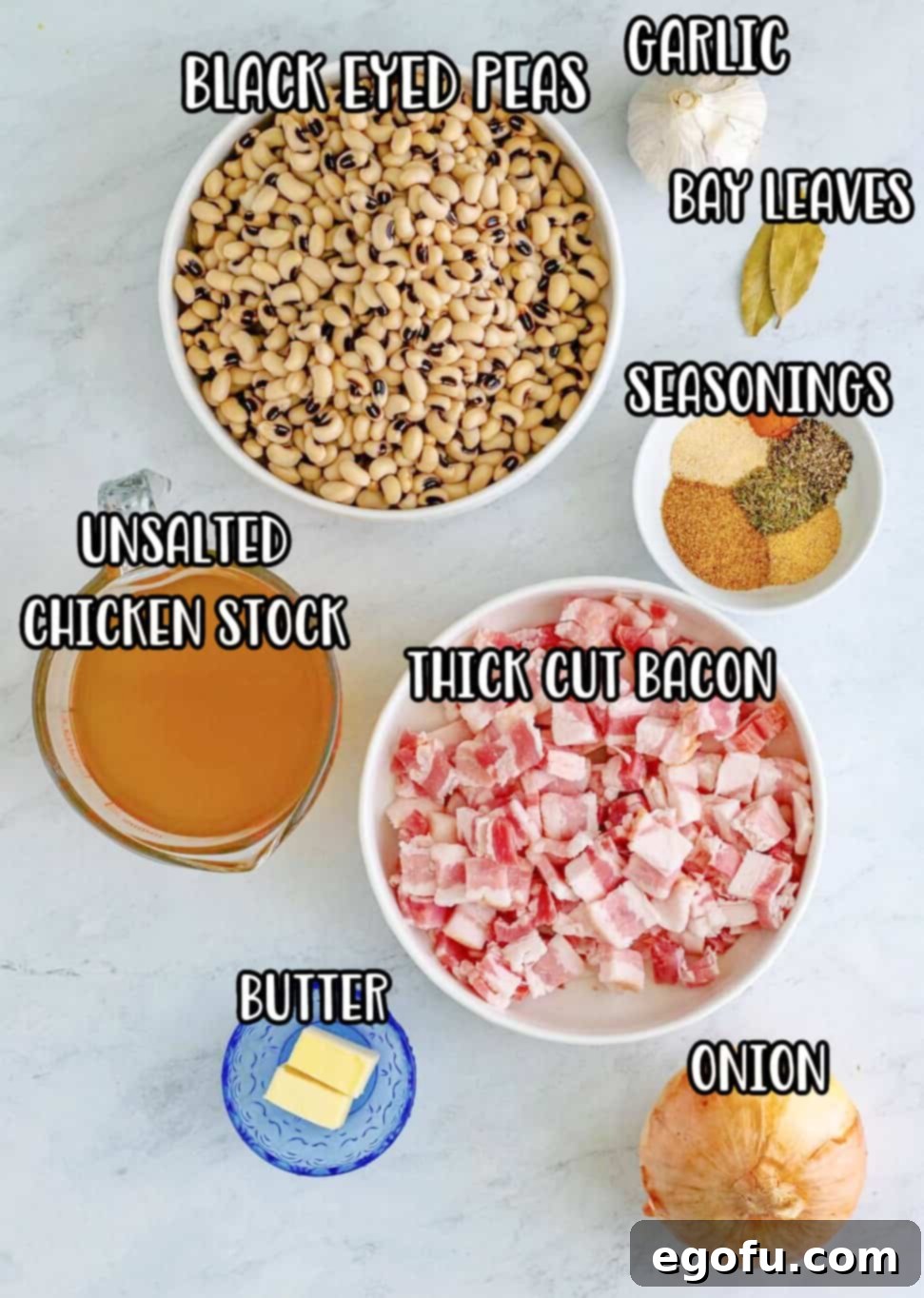
How to Make Delicious Southern Black Eyed Peas: A Step-by-Step Guide
Follow these detailed steps to create a pot of the most flavorful Southern Black Eyed Peas that will impress even the most discerning palates. Each step builds on the last to ensure a rich, well-rounded flavor profile.
Step 1: Crisp the Bacon and Sauté Aromatics. Begin by cooking the diced thick-cut bacon in a heavy-bottomed Dutch oven or large pot over medium heat. Stir occasionally for 15-20 minutes until the bacon is beautifully crispy. This step is essential as it renders out the flavorful bacon drippings, which will be the base for our aromatics. Once cooked, remove the crispy bacon with a slotted spoon and set it aside on a paper-towel-lined plate to drain, reserving all the savory drippings in the pot. Next, add the small diced sweet onion to the pot, cooking it in the bacon fat until it softens and becomes translucent, which typically takes about 10 minutes, with occasional stirring. Finally, add the minced fresh garlic and cook for just 30 seconds more until it releases its fragrant aroma. Be careful not to burn the garlic, as this can impart a bitter taste.
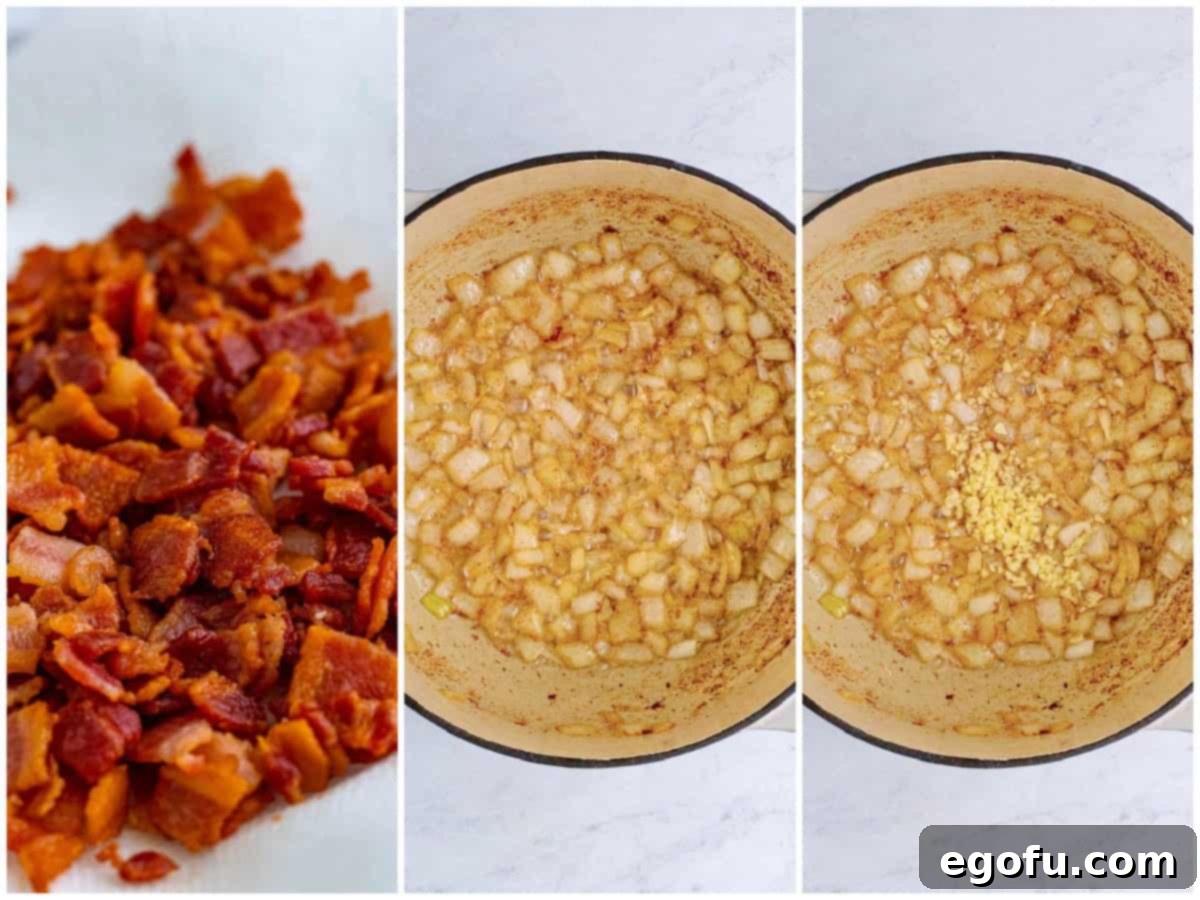
Step 2: Build the Flavor Base. To the pot with the softened onions and fragrant garlic, add the seasoned salt, garlic powder, onion powder, dried thyme, black pepper, and cayenne pepper. Stir these seasonings into the mixture and cook for another 30 seconds. This brief cooking time allows the spices to bloom in the warm bacon fat, intensifying their flavors and aromas. Next, add the pre-soaked and drained black-eyed peas to the pot, along with the unsalted chicken stock and bay leaves. Give everything a good stir to ensure all ingredients are well combined and the peas are submerged in the liquid. This combination of stock and spices will infuse the peas with incredible depth.

Step 3: Simmer to Perfection and Final Touches. Bring the mixture to a boil over medium-high heat. Once boiling, reduce the heat to a low simmer, cover the pot, and let it cook for 60-90 minutes. Stir occasionally to prevent sticking and ensure even cooking. The peas are ready when they are tender and creamy, having absorbed the rich flavors of the broth. Cooking time can vary depending on the freshness and soaking duration of your peas, so taste-test for tenderness. Finally, stir in the unsalted butter until it melts completely, adding a luscious finish. Taste the black eyed peas and adjust the seasoning if necessary, adding more salt, pepper, or cayenne as desired.
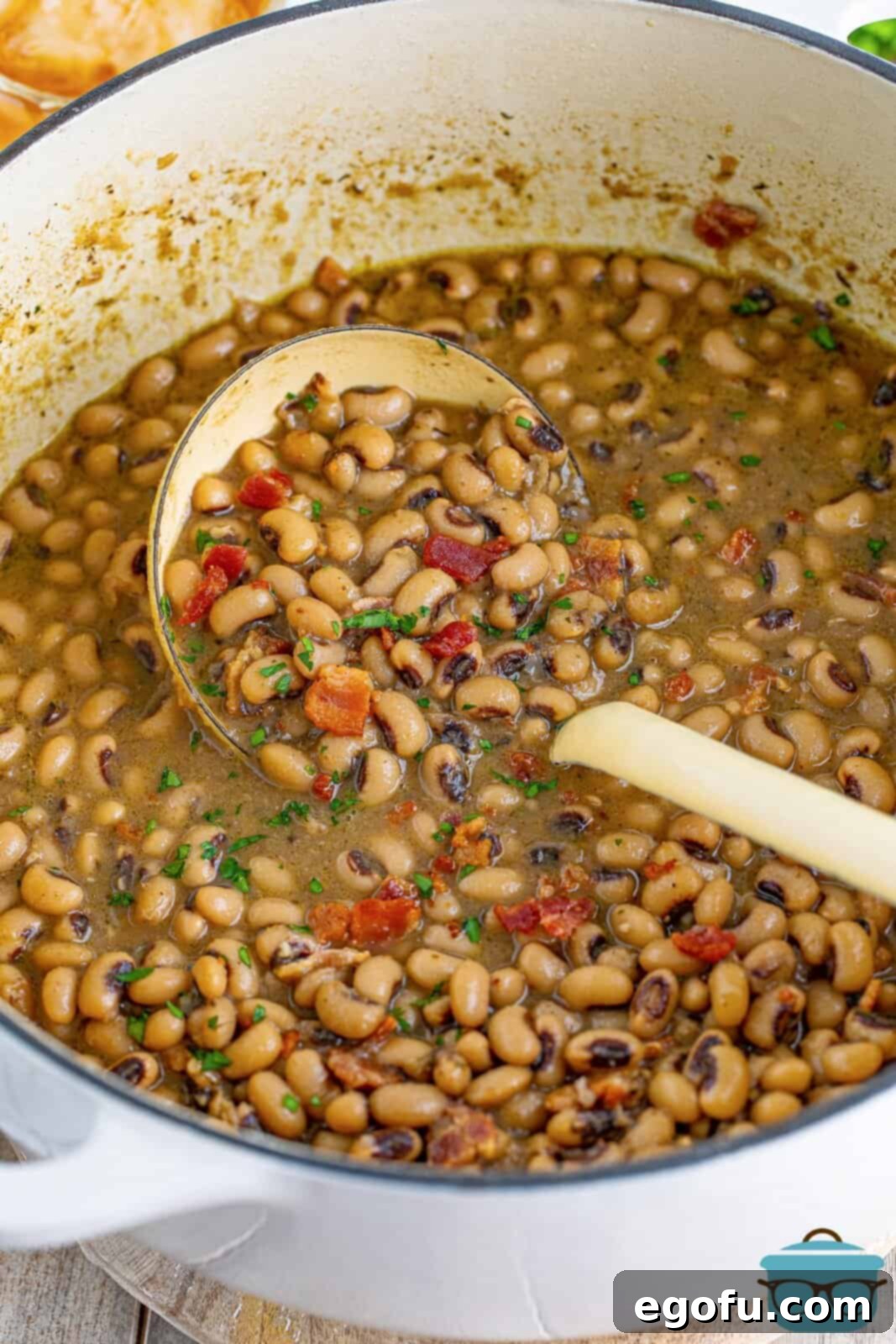
Serve your Southern Black Eyed Peas hot, garnished generously with the reserved crispy bacon and a sprinkle of fresh parsley for a touch of color and freshness. Enjoy this delightful taste of the South!
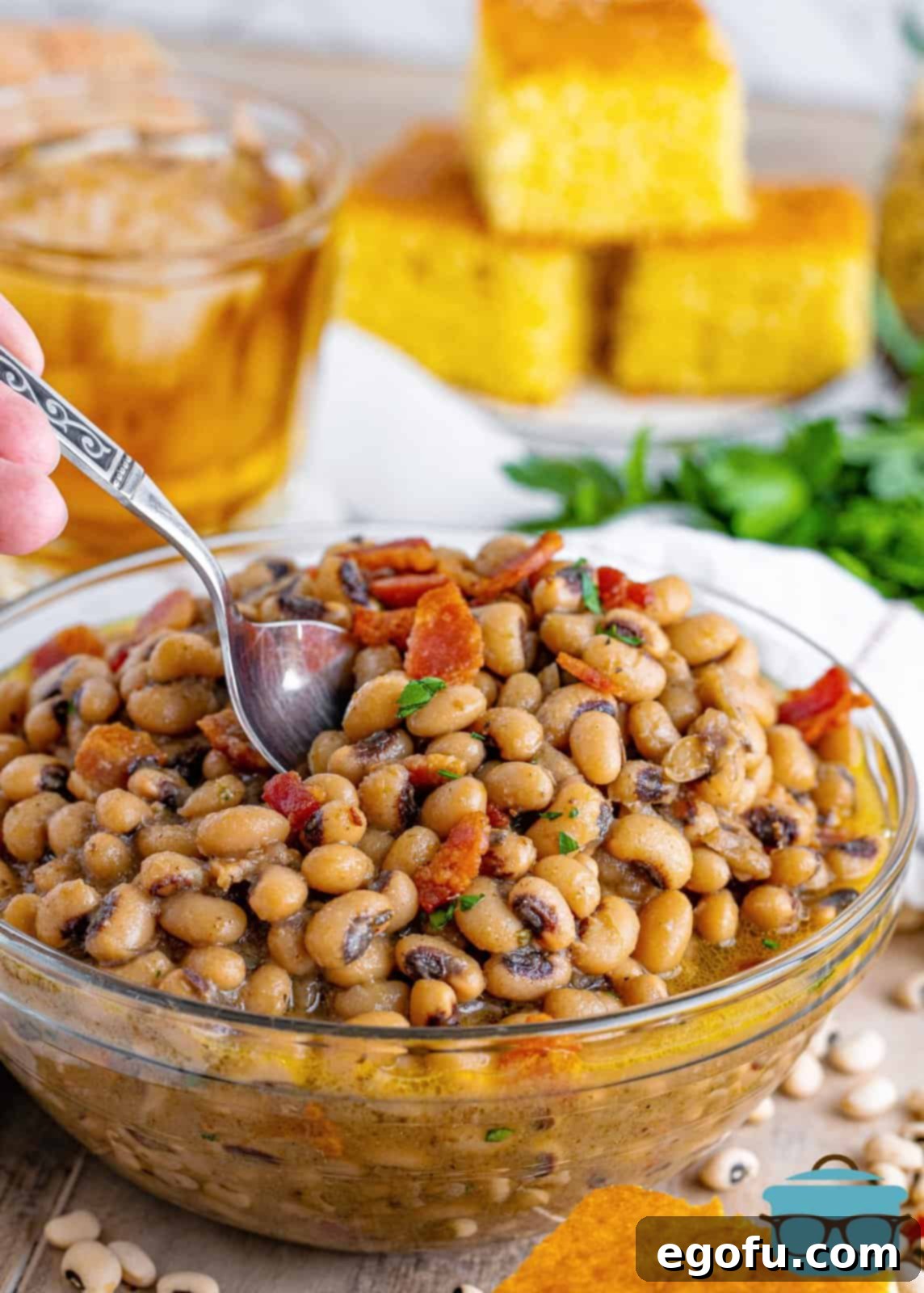
Want More Delicious Southern-Inspired Recipes?
If you’ve enjoyed the comforting flavors of these Southern Black Eyed Peas, you’ll love exploring more classic dishes from the American South. Expand your culinary horizons with these fantastic recipes that are sure to become family favorites:
- Slow Cooker Hoppin’ John – Another New Year’s Day staple, made effortlessly in your crock pot.
- Black Eyed Pea Salad – A refreshing and vibrant twist on using black eyed peas.
- The Best Southern Fried Chicken – Crispy, juicy, and utterly irresistible.
- Fried Green Tomatoes – A tangy and savory Southern classic.
- Red Beans and Rice – A soulful, flavorful, and filling Louisiana favorite.
- Chicken Étouffée – A rich and spicy Creole stew that’s perfect over rice.
- Chicken Fried Steak – Tenderized steak with a crispy coating, often served with sawmill gravy.
- Crock Pot Southern Style Grits – Creamy, comforting, and perfect for breakfast or as a side.
- Homemade Hush Puppies – Crispy, golden, and savory cornmeal fritters.
- Fried Potatoes – Simple yet incredibly satisfying, a staple with any Southern meal.
- Chow Chow – A tangy, sweet, and spicy pickled relish.
- Southern Fried Apples – Sweet, tender apples cooked until caramelized, a delightful dessert or side.

Southern Black Eyed Peas
These Southern Black Eyed Peas are packed with incredible flavor thanks to savory bacon and a blend of delicious seasonings! A versatile and essential addition to all your meals, perfect for any occasion.
Pin Recipe
Prep Time: 15 minutes
Cook Time: 2 hours
Soak Time: 8 hours
Total Time: 10 hours 15 minutes
Servings: 12
Author: Brandie Skibinski
Ingredients
- 12 ounces thick-cut bacon, 1/2-inch diced
- 1 small sweet onion, small diced
- 3 cloves garlic, minced
- 2 teaspoons seasoned salt
- 1 teaspoon garlic powder
- 1 teaspoon onion powder
- 1 teaspoon dried thyme
- 1 teaspoon black pepper
- ¼ teaspoon cayenne pepper (adjust to taste)
- 1 pound dried black-eyed peas (soaked overnight and drained)
- 4 cups unsalted chicken stock
- 2 dried bay leaves
- 2 Tablespoons unsalted butter (optional, for richness)
Instructions
In a Dutch oven (or large pot) over medium heat, cook the thick-cut bacon until crispy, about 15-20 minutes, stirring occasionally. Once cooked, remove the crispy bacon and place it on a paper-towel-lined plate, reserving the bacon drippings in the pot.

Add the small diced sweet onion to the pot with the bacon grease. Cook until softened and translucent, approximately 10 minutes, stirring occasionally.

Stir in the minced garlic and cook for about 30 seconds, or until it becomes fragrant.

Add the seasoned salt, garlic powder, onion powder, dried thyme, black pepper, and cayenne pepper to the pot. Stir to combine and cook for 30 seconds to allow the spices to bloom.

Stir in the soaked and drained black-eyed peas, unsalted chicken stock, and bay leaves until well combined.

Bring the mixture to a boil, then reduce the heat to a low simmer. Cover the pot and simmer for 60-90 minutes, stirring occasionally, until the peas are tender. Cooking time may vary.
Add the unsalted butter (if using) and stir until melted. Taste and adjust seasonings as needed.

Serve hot, topped with the crispy bacon and fresh parsley, if desired.

Video
Notes
- For detailed substitutions or answers to common questions, please refer to the FAQ’s and ingredient list provided above in the article.
- A “quick soak” method for the peas is available if overnight soaking isn’t feasible; instructions are detailed in the FAQ section.
- These black eyed peas can be frozen for up to 3 months; refer to the FAQ section for proper freezing and defrosting instructions.
- Always remember to sort through dried peas to remove any small rocks or natural debris before soaking and cooking. This is a common and important practice for dried legumes.
Course: Side Dish
Cuisine: American, Southern
Nutrition
Calories: 287kcal
Carbohydrates: 27g
Protein: 14g
Fat: 14g
Sodium: 608mg
Fiber: 4g
Sugar: 4g
Nutritional Disclaimer
“The Country Cook” is not a dietician or nutritionist, and any nutritional information shared is an estimate. If calorie count and other nutritional values are important to you, we recommend running the ingredients through whichever online nutritional calculator you prefer. Calories and other nutritional values can vary quite a bit depending on which brands were used and exact portion sizes.
Did you make this recipe?
Share your culinary creations! Tag us on Instagram @thecountrycook and use the hashtag #thecountrycook!
